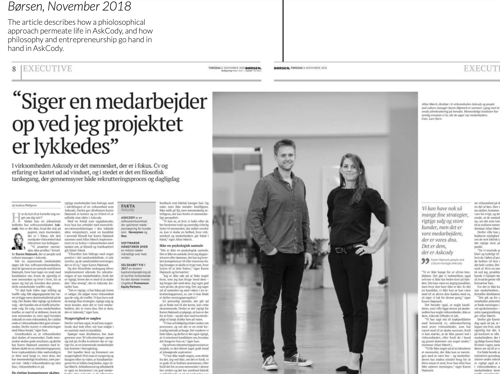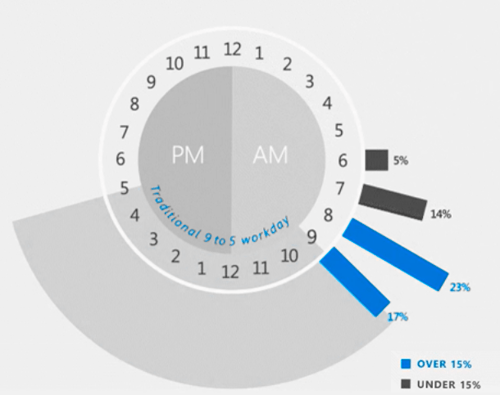We hear it all the time: “The future of work is hybrid”. But we argue that the future is now the present and has been for a long time now. So, if you missed the train, you need to ask yourself, how you keep pace with the modern workplace culture before the next big thing hits. (Hint; you can read more about our predictions for the future in this blog post: The top six trends in the future of work).
In this post, we have collected all we could think of about hybrid working in one piece, so you can catch up. Let us further treat you with a smooth implementation and management guide, because hybrid working is, indeed, here to stay.
What is hybrid working?
The term hybrid working emerged during the pandemic and involved two elements (1) working remotely and (2) working at the office. There is no exact definition of the combined word, hybrid working, but it is a combination of the words:
Hybrid means "a thing made by combining two different elements".
Working means "doing an activity, such as a job".
Thus, it means that a hybrid worker could have one workday at home, or another location not shared with colleagues per week, or only one day in the office per week – but also everything in between. Now it is up to you to find the optimal balance for your workers.
Why hybrid work?
During the pandemic, most people were expected to work from home, and during this time it was an eye-opener for both companies and their hires. Working from home gave flexibility and freedom, but at the same time, when the office reopened many also started craving the community of the office not wanting to go solemnly remote. Thus, the need for something in-between arose, and you must figure out what fits your company best. Several studies have verified that most people like working from home - but they do not want to work remotely every day. 54% of the Steelcase Research subjects admitted that they expect to go to the office, but that they want to work from home at least one day per week. While these trends that have emerged may not be a perfect fit for some businesses and organizations, it is important to consider the options and learn through this situation, as organizations are hit by an expectation that they will make a hybrid working transition. So even though, hybrid working have been a thing for some companies already before the pandemic since digitalization and globalization enabled hybrid working, the pandemic has severely magnified the need for it and thus became something everyone talks about. So confirms founder and CEO Allan Mørch, AskCody as he explains how he embraces it:
“We have always embraced working distributed and using technology to empower us even before hybrid was a thing. We always ask ourselves what fits the situation best: For this task, that I need to do now – is the preferred working situation to focus at home or is it better for me to do this task if I am with people?”
Which companies are hybrid working?
In not already now, likely soon your competitor will have made the transition and vacuumed the market for talent. You will find that most companies are already hybrid working in various ways. If you want to catch up and be ready for the constantly accelerating demand for hybrid working, you can get inspiration from how others beat you to it in our collection of hybrid work examples before implementing yourself. In that way, you will know all there is to know about it before getting started and selecting the way that fits your organization. Everything you need to know about this topic is covered in this post with examples, and you will see why hybrid working is here to stay.
Why hybrid working spells trouble for companies
There are many challenges when it comes to hybrid working. When we started navigating the return to office, we were put in a situation where working patterns were shifting. We still want employees to come to the office to interact, so maybe we make some days mandatory? But then what happens when they start going to the office on the same days? You will have a crowded and overbooked office. Then we are left with overbooked meeting rooms and not enough desks - which will then be empty the day after.
This is a common example and something e.g. The Wall Street Journal noted that Salesforce.com Inc. has experienced when offices reopened. In their case, Thursdays became the day when most employees came to the office, which created a high demand for meeting rooms and collaboration spaces. Nevertheless, there is often a solution to everything if you look for them. What they did was redesign the office to fit the new needs. That could for example be by creating co-working spaces, or cafes that will foster collaboration when people are at the office, but also smaller individual spaces like desks or phonebooths. Moreover, when redesigning your office, you will simultaneously optimize your resources and improve room utilization, hence cutting down on office space costs by rethinking your facilities. Real estate is often one of the most expensive costs, and if you can minimize that and affect your sustainability – it is a win-win.
Moreover, you might be wondering what the real cost of hybrid working is, and whether it will affect your ability to deliver on promises. However, The Economist reports that even though there has been a large increase in the amount of people working from home lately, the shift to hybrid working has gone better than expected. They report that people are working longer hours, but are reporting a higher level of happiness and productivity when they have more freedom and control over their own schedule.
But then again - you might also worry that giving the employees the freedom to work hybrid can cause, division in the workforce. The workers who stay remote could possibly fall behind in the social area and may feel left out, as they are not involved with the other coworkers. That might set them behind when they cannot as easily be part of discussions at work or solve problems face to face. Thus, they might fall behind in the race for promotions and pay as they lag behind. That further highlights the problem of being part of and experiencing company culture.
“Culture eats strategy for breakfast.” - Peter Drucker
We used to rely on company culture to be through exposure, and it was something new hires had to experience firsthand. Because it is not just a written value statement, but the feel and vibe of the office. While old employees had the opportunity to learn through firsthand experience, many new hires might have been employed during the pandemic or are working remotely, so they will only read about it, and thereby do not get the full cultural experience. Thus, you must expose someone new to the culture if they are not around by for example making onboarding in the office mandatory.
However, consider the cultural problem already at the beginning of your hiring process. Maybe we need a shift in mindset and look for the right fit to our company culture by personality, and then view skills as something teachable. Because with the right people, you will never experience the mismatch. Our founder and CEO Allan Mørch, AskCody always says:
“We cannot forget ourselves when we grow, we need to be very detailed when we recruit new employees. We do not hire based on some numbers but based on the competencies and cultural fit. We have said no to candidates with a perfect resume, but where we thought they were a bad match to the rest of the team and our company culture, and it has to be the right fit for everyone, not just for me.”
AskCody has multiple times been nominated as the best workplace of the year on its home turf, the city of Aalborg, which attracts many employees.
 Newspaper clipping from Danish Newspaper Børsen
Newspaper clipping from Danish Newspaper Børsen
So maybe challenges are solvable if you are willing to adapt. Either way, many companies are coming to terms with the fact that hybrid working is here to stay, and you must figure out how to deal with it if you want to enter the era of hybrid working.
Why hybrid working is the future
The pandemic will have a lasting impact on work. A survey of 9,000 workers by Accenture PLC found that 83% of respondents viewed a hybrid workplace as optimal, which means companies need to figure out new ways of working, and fast. If you do not offer hybrid working it might be difficult to attract talent, as workers are not willing to work from the office all week, they want the option to work from home at least some of the time. It is becoming a requirement for workers, and you will risk missing out on the top candidates if you are not willing to match their expectations for the optimal working environment. One of the most expensive 'resources' for businesses is people, and hybrid working might be the blessing that will make your people want to stay and the talent wants to work for you. Thus, your flexibility will affect your ability to attract but also to retain talent - so you need to keep job satisfaction high, embrace their wishes, and pick your hybrid working model.
What is a hybrid work model?
When talking about hybrid working there are often four ways of categorization. A company could have all four categories of hybrid working within their company.
The four types of hybrid working models are:
- In-office: When organizations prefer to have their employees physically at the office to perform their tasks
- Working from home: When employees have a physical desk at the office location, but have the option to work flexibly from home or other places outside the office as well
- Remote work: When employees are working primarily from home, or constantly switching between various locations
- Distributed work: When employees can choose to work from anywhere, but they do not have the option of going to the office
The Wall Street Journal has noted that it is common to utilize more than one model. For example, they highlight the example of the global technology company Sabre Corp., where now roughly 25% of Sabre's 7,500-person staff resume a standard office workweek. While about 30%, or 2,250 people, will stay remote, and the remaining 45% will come into the office to collaborate with peers one or two days a week. Nevertheless, if you want to be sure that your hybrid working model gives you results you need to trust the workers you have recruited to be able to hold ambitious standards of work ethics anywhere before you can get the benefits of your model.
Accenture found in their ‘Future of Work Study 2021’ that 63% of high-revenue-growth companies, already enabled multiple models, and allow productivity anywhere. While 69% of negative or no-growth companies are still focused on where people are going to physically work, favoring one model of in-office or remote work rather than enabling multiple models and embracing hybrid. So which group do you want to be in?
Why hybrid working works
If you want your employees to stay it is important that flexibility goes both ways. If you give them the opportunity for a better work-life balance, where they do not have to go to the office every day you are giving them the gift of getting more done instead of binding them to for example live near their workplace or consequently spend time getting there in traffic. You are giving them the option to buy a house further away from headquarters because they do not need to go to the office every day, which gives them time to do much more of what makes them happy or to take care of their responsibilities at home. Read up on why you should consider working from anywhere in the blog.
In return, Microsoft Teams noted in their last report, that the average time between their customer’s first and last use of Teams had increased by over one hour. The data suggests that people are working more frequently in the morning and evening hours. Teams chats in these times outside of the typical workday have increased between 15% and 23%. People also work during the weekend and Teams chats on Saturday and Sunday have increased by over 200%. People get their work done when they have time and on their schedule from wherever they want.
 Percentage change of Microsoft Teams chats Adapted from: Microsoft Teams Report
Percentage change of Microsoft Teams chats Adapted from: Microsoft Teams Report
With a flexible work schedule, workers can be more productive and take breaks when they need to, and you will keep job satisfaction high. Accenture found in their ‘Future of Work Study 2021’ that 85% of people who feel they can be productive everywhere say that they plan to stay with their company for a long time. Hence, you will be rewarded with loyal employees.
With this possibility, recruitment will also suddenly become easier. If you are not so geographically bound, there will be no geographical limitations. You can hire talent from other areas or even countries. As Tope Awotona the founder and CEO of Calendly so nicely puts it in the Wall Street Journal;
"We want to be what we call a remote-first company, but not a remote-only company. We want to eliminate the expectation that anybody has to be in the office. All we care about is that you get your job done from anywhere, you hit your goals and you make yourself available."
And many might not find that as an unfair request...
How to manage hybrid work
As some employees come back to the office and others remain out of the office, companies must make new regulations and set expectations for hybrid working. This can be a complex challenge. Many executives are in doubt about what this new era should look like. The big question is: How much flexibility does the worker want? Should it be the same for everyone or can we decide on who works from where and when? How do we foster human connections if people are not together? Can we onboard employees remotely? You need to come up with a strategy fitting the needs of the workers. Get your plan in place. Is it a new office design, new technologies, or maybe new policies that will ensure a smooth transition? A new hybrid working model requires thought, adjustments, and process change. Remember to continuously make sure that culture and morale are still high by utilizing employee experience surveys as part of your commitment to open communication. We have collected some of the learnings management in AskCody has made about managing hybrid work in AskCody in the video below.
How to implement hybrid working
To adhere to the change hybrid work brings, it is important to invest in new technologies that improve your team's efficacy and performance. Consider investing in an online workplace where everything is tidy and easy for your employees to navigate so you can enhance productivity. You need a plan for security, file sharing/storage, and project management.
You can also make it easy for your employees to decide on which meetings they do online and which at the office, by having access to an overview of bookable resources (meeting rooms and desks) at the office. For an effective hybrid working strategy, employees should be able to interface with the office no matter where they are, and at AskCody we help minimize the complexity of hybrid working. We see this strategy work well when employees have a tool to book desks and meeting rooms for themselves when want to go to the office - even if the number of days is constantly changing every week. We make it possible to have both desk hoteling and hot desking.
Thereby, employees can take full control of their workday planning. If you further ensure that you have an overview of the exact bookable resources you need with Workplace Analytics, you can make sure no one works from home just because they cannot find a seat at the office. The capacity problem can further be avoided if you have a Visitor management system, so you can see who is or was in the office that day and maintain a compliant capacity. You can hear more about how AskCody supports the hybrid workplace in our on-demand webinar.
Hybrid working policies
Microsoft’s report on ‘The Future of Work’ concluded that surveyed managers and employees all agree. Working from home must be an option long-term. 82% of managers surveyed expect to have more flexible work-from-home policies post-pandemic. Guidelines have become a need-to-have not a nice-to-have, but it can be frightening to leave the decision up to the individual, so you need a place to start. At Hubspot, they have built a hybrid working policy, and they started by including it in their Culture Code which states:
“We’ve always believed that results matter more than when or where they’re produced.”
... or as we say at AskCody:
“Work is something you do – not a place you go”
So, after making sure your cultural statements fit your new hybrid working model, you will eventually need a new hybrid working policy. So, how to get started?
When implementing a hybrid working policy you need to consider multiple variables. Harvard Business Review describes that you should start by considering what key stakeholders care about and follow the following steps:
- Collect data on the matter. A survey where people are asked what their top priorities and objectives are when it comes to a hybrid working policy and which model they prefer. When gathering opinions, it is a good idea to conduct the survey anonymously to generate the most accurate and comprehensive understanding of the results, and it is important to pay attention to the response rate if you want to make sure your data is not biased. Everyone should be given multiple opportunities to answer the survey.
- Make a priority list and preference list and visualize it. Thereby, helping decision-makers understand the results. When making sense of data a discussion group is a good idea to understand what is most important for decision-makers, and what is their biggest concern.
- Make tradeoffs. A negotiation does not necessarily need to be a full solution at first, but more of an overview of what to care about based on the results. First, when you understand everyone’s position, it is time to find a solution. In this case, one single solution is optimal, but it is not always the best or most fitting for your company, so be creative in your solution and come up with alternatives. Every work environment is complex and continually changing, thus it is unrealistic to have a one-size-fits-all solution.
- Revise and revisit. Ensure a fit by reassessing continuously, as priorities and options change. The market will change, and so will the labor pool and the work culture, so check that your policy remains aligned. A policy with an expiration date can ensure that you do not have a policy in place that has long passed.
Now you need to find the best balance between the customer, employees, and organization's needs. We often see that change management is being overlooked and underestimated, thus, remember to ensure a smooth transition by making sure that concise communication, trust, and patience are some of the highest priorities in your organization if you want to change with grace. Good luck.



